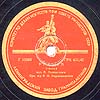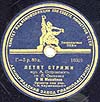1900-1940
Boom of 78 rpm
Local Industry
Long Playing
Special Issues
"Sounding Letters"
Envelopes
Listen Records
Guestbook
Radio Museum
SHELLAC DISK |
| Introduction 1900-1940 Boom of 78 rpm Local Industry Long Playing Special Issues "Sounding Letters" Envelopes Listen Records Guestbook Radio Museum |
|
Disks with traverse recording and radial velocity of 78 rpm was the only type of record in this country for over 60 years. To the end of that period (early 1950s) instead of mechanical "pathephones", different devices for playing plates with electric drive of the disk and electronic amplifiers on radio valves came to be widely used. At first those were "electric pathephones" and then - electric players and radiogramophones of varied designs. The ordinary steel gramophone needle that had to be changed after playing only one side of the plate was ousted by a more wear-proof one with sapphire cap. |
 |
Approximately
by the same time a synthetic substitute for the expensive
imported shellac - polyvinyl cloride was found. The
inscription about the new material was placed on labels
of the disks of that time ("Shellacless - PVC")
Plates made of shellac were turned out simultaneously.
Collectors know that rather a pleasant scent that can be
felt when opening a box with such disks. |
 |
 |
Left - a label of Leningrad Works of early 1960s. Right - a label of "Ligo" factory of gramophone records in Riga (end 1950s). |
 |